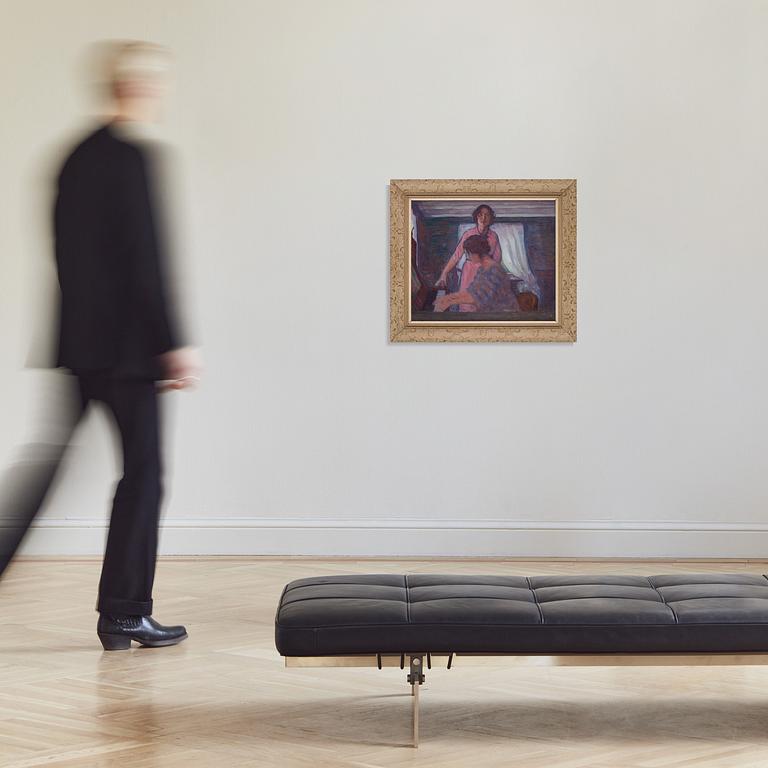Björn Ahlgrensson
By the piano
Signed BA. Canvas 52 x 61 cm. Bukowskis thank Adam Korpskop for information about the artwork.
Alkuperä - Provenienssi
Acquired directly from the artist, early 20th century, by the writer and teacher Henning Olsson, Sunne, Värmland.
Thence by descent in the family.
Muut tiedot
"Get there immediately! I have discovered the most wonderful place in the world. Outside Arvika by a lake called Racken. What is Italy to that!"
Gustaf Fjaestad supposedly said this when he met fellow artist Björn Ahlgrensson and his wife Elsa Lindström on Drottninggatan in Stockholm in the year 1900. The artist's invitation would prove to be a turning point for the newly married couple, whose life situation at the time was fraught with difficulties.
Ahlgrensson had been living in Stockholm since 1890 when he moved back to Sweden after living in Paris for much of his life. Through his father, himself a recognized decorative painter, Björn was employed as an apprentice in Carl Grabow's workshop. Here he met another apprentice, Fritz Lindström, who became a close friend and colleague.
Both Ahlgrensson and Lindström then managed to get in touch with the “Konstnärsförbundet” and were accepted as students in its school. Ahlgrensson painted diligently into the night and was constantly engaged in color experiments. Konstnärsförbundet saw promise in him and offered him a scholarship to go on an educational trip to Paris. The trip was not long, but he met the artists Ivan Aguéli and Olof Sager-Nelson, who introduced him to synthetism. When he returned to Stockholm, influenced mainly by Karl Nordström, he began to explore Nordic nature mysticism and his color palette became darker and duller. He received critical acclaim and was elected to the Swedish Artists' Association, but at the same time his financial situation was serious.
In 1900, Ahlgrensson married Fritz Lindström's sister Elsa and their first years together were characterized by poverty and a lack of prospects. They did not even have a stable home at this time. It was then that they came across the artist Gustaf Fjaestad on Drottninggatan. Two years earlier, he had settled in Racken, outside Arvika in Värmland, with his wife Maja, and when he heard about the newlyweds' difficulties, he offered them to move into sculptor Christian Eriksson's studio home Oppstuhage in the Värmland town.
Björn and Elsa took up Fjaestad's offer and moved into the studio apartment. Later, their friend and brother-in-law Fritz Lindström also moved in. Ahlgrensson began to explore the landscape of Värmland with the symbolist and atmospheric imagery so popular at the turn of the century. They soon moved out of the studio residence and moved to Perserud, and it is here that he would paint some of his most famous works in the first decade of the 20th century.
In addition to landscapes, Ahlgrensson was also a skilled interior painter and portraitist. The paintings from his home in Perserud were appreciated by Ernest Thiel, among others, who bought "Det snöar ute" from 1905. In the current auction, we see two female figures at a piano. While one woman sits and plays, the other stands beside her and looks straight at the viewer. We do not know the identities of these women, but the painting reflects an important aspect of the Rackstad colony: the community. One theory is that the women are Elsa Lindström and Maja Fjaestad. Gustaf and Maja Fjaestad spent a lot of time with Björn and Elsa, and Björn painted a famous portrait of Maja that is now in the Rackstad Museum's collection.















































